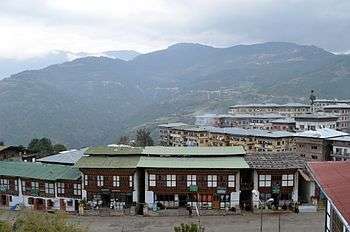Mongar District
Coordinates: 27°10′N 91°10′E / 27.167°N 91.167°E


Monggar District (Dzongkha: མོང་སྒར་རྫོང་ཁག་; Wylie: Mong-sgar rdzong-khag) is one of the 20 dzongkhags (districts) comprising Bhutan. Monggar is the fastest-developing dzongkhag in eastern Bhutan. A regional hospital has been constructed and the region is bustling with many economic activities. Monggar is noted for its lemon grass, a plant that can be used to produce an essential oil. It also has a hydro power plant on the Kuri Chhu river.
Languages
Mongar is home to a variety of Bhutanese languages and dialects. In the east, the East Bodish Tshangla (Sharchopkha) is the dominant language, also used as a regional lingua franca.[1]
Central Mongar is the only region where the East Bodish Chali language is spoken, by about at total of 8,200 people in Wangmakhar, Gorsum and Tormazhong villages, mainly in and around Chhali Gewog on the east bank of the Kuri Chhu River.[1]
Southern Mongar is likewise unique for its 1,000 Gongduk speakers living in a few inaccessible villages of Gongdue Gewog near the Kuri Chhu river. The language appears to be the sole representative of a unique branch of the Tibeto-Burman language family [2] and retains the complex verbal agreement system of Proto-Tibeto-Burman.[3]
In southwestern Monggar, residents speak Khengkha, an East Bodish language closely related to Bumthangkha languages including Kurtöp. Bumthangkha itself is also spoken by the natives of extreme northwest Mongar. Residents of the Kuri Chhu valley of northern Monggar speak Chocha nga cha kha, a Central Bodish language very closely related to Dzongkha, the national language.[1][4][5][6][7]
Administrative divisions
Monggar is divided into seventeen village blocks (or gewogs):[8]
Geography
Western Monggar District contains part of Thrumshingla National Park (the gewogs of Saling and Tsamang), and northeastern Monggar District contains part of Bumdeling Wildlife Sanctuary (the gewog of Sharmung).[8][9]
See also
References
- 1 2 3 van Driem, George L. (1993). "Language Policy in Bhutan" (PDF). London: SOAS. Retrieved 2011-01-18.
- ↑ Himalayan Languages Project. "Gongduk". Himalayan Languages Project. Retrieved 2009-11-06.
- ↑ Ethnologue. "Gongduk: A language of Bhutan". SIL International. Retrieved 2009-11-06.
- ↑ "Chalikha". Ethnologue Online. Dallas: SIL International. 2006. Retrieved 2011-01-18.
- ↑ "Chocangacakha". Ethnologue Online. Dallas: SIL International. 2006. Retrieved 2011-01-18.
- ↑ "Bumthangkha". Ethnologue Online. Dallas: SIL International. 2006. Retrieved 2011-01-18.
- ↑ van Driem, George (2007). Matthias Brenzinger, ed. Language diversity endangered. Trends in linguistics: Studies and monographs, Mouton Reader. 181. Walter de Gruyter. p. 312. ISBN 3-11-017050-7.
- 1 2 "Chiwogs in Monggar" (PDF). Election Commission, Government of Bhutan. 2011. Retrieved 2011-07-28.
- ↑ "Parks of Bhutan". Bhutan Trust Fund for Environmental Conservation online. Bhutan Trust Fund. Retrieved 2011-03-26.